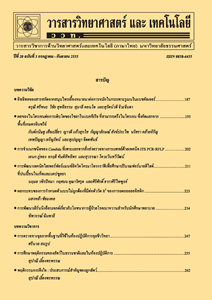การใช้แบบจำลอง SWAN เพื่อศึกษาลักษณะคลื่นในอ่าวไทยในช่วงที่เกิดพายุไต้ฝุ่นหมุ่ยฟ้า
Main Article Content
Abstract
บทคัดย่อ
แบบจำลองและการทำนายคลื่นของพายุหมุนเขตร้อนเป็นหัวข้อที่ได้รับความสนใจมาเป็นเวลานาน เนื่องจากคลื่นที่เกิดจากพายุหมุนเขตร้อนเป็นสาเหตุสำคัญที่ก่อให้เกิดความเสียหายต่อชีวิตและทรัพย์สินเป็นอย่างมาก วัตถุประสงค์ของการศึกษานี้คือ การใช้แบบจำลอง SWAN เพื่อศึกษาลักษณะของคลื่นในอ่าวไทย โดยเฉพาะในช่วงที่พายุไต้ฝุ่นหมุ่ยฟ้าพัดผ่านอ่าวไทยในระหว่างวันที่ 25 - 26 พฤศจิกายน พ.ศ. 2547 โดยความสูงคลื่นนัยสำคัญที่ได้จากแบบจำลอง SWAN จะนำมาเปรียบเทียบกับข้อมูลที่ตรวจวัดได้จากดาวเทียม Environmental Satellites (ENVISAT) และ Geosat Follow-On (GFO) และประเมินประสิทธิภาพของแบบจำลองโดยใช้ดัชนีการกระจาย (Scatter Index, SI) จากผลการศึกษาพบว่า ถึงแม้ว่าความสูงคลื่นที่ได้จากแบบจำลองจะมีค่าต่ำกว่าความสูงคลื่นที่ตรวจวัดจากดาวเทียม แต่ยังคงมีค่าใกล้เคียงกับความสูงคลื่นที่ตรวจวัดอยู่ประมาณ 85.00% - 90.17%, ค่าสัมประสิทธิ์สหสัมพันธ์มีค่าตั้งแต่ 0.83 - 0.92 และดัชนีการกระจายมีค่าตั้งแต่ 13.65% - 18.57% ซึ่งแสดงให้เห็นว่าแบบจำลอง SWAN มีความสามารถเพียงพอ ในการพยากรณ์ความสูงคลื่นในอ่าวไทย ในการศึกษาต่อไปจำเป็นต้องมีการปรับปรุงแบบจำลองให้มีประสิทธิภาพมากยิ่งขึ้น
คำสำคัญ : อ่าวไทย; ไต้ฝุ่นหมุ่ยฟ้า; แบบจำลอง SWAN, ความสูงคลื่น
Abstract
Model and prediction wave of tropical cyclone is an interested topic for many years because wave height associated with tropical cyclone is a cause of severe damage to life and property. The objectives of this study were to apply the SWAN model to investigate wave characteristic in the Gulf of Thailand, in particular for the event of typhoon Muifa pass through the Gulf of Thailand during 25 - 26 November 2004. The significant wave height from the SWAN model is compared with the Environmental Satellite (ENVISAT) and Geosat Follow-On (GFO) wave data and the performance of SWAN model evaluated by the Scatter Index (SI). The result revealed the significant wave height from the SWAN model was underestimated with altimeter data but it is good agreement with the measured data approximately 85.00% - 90.17%, the correlation coefficients vary between 0.83 - 0.92 and the scatter index values vary between 13.65% - 18.57%. These values indicate the SWAN model is good enough for the use of the Gulf of Thailand wave forecast, but it still needs some improvement on adjusting model efficiency.
Keywords: gulf of Thailand; typhoon Muifa; SWAN model; wave height


